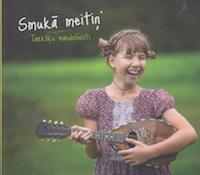CanZone, a group that combines elements of rock, Latvian folk, and pop music, was formed in 2009 in the Grīziņkalns area of Rīga. The band name – ‘CanZone’ – is taken from the Italian word ‘canzone’ (or song), and the band has explained that this name was chosen almost at random, while looking through an Italian dictionary. They released their debut album High Time in 2018, and half of the album’s songs are in Latvian, the other half are in English.
The group is made up of Dagnija Millere-Balandīna on vocals, accordionist Rolands Zelčs, Oskars Krūklis on bass, Raivo Millers playing guitar, and drummer Artūrs Slaviks. The group’s sound may remind some listeners of 1970’s hard rock, particularly groups like Deep Purple, Led Zeppelin, and at times even Black Sabbath.
The band puts the accordion front and center throughout its music, starting with the first track on the album – ‘Pirmssalnas dziesmiņa’, a song with lyrics by Māris Čaklais, and the song proves to be an appropriate introduction for the band and its sound. The song begins with Zelčs’ vigorous accordion, which is then joined by Slaviks’ thundering drums and Krūklis’ bass guitar, as well as Millere-Balandīna’s confident, throaty vocals and Millers’ brawny, distorted guitar. In fact, the singer revealed that she was once asked to leave a choir, as her singing style was considered to be too ‘different’.
Millere-Balandīna describes the song ‘Pašrūpe’ as a song about ‘opening one’s mind, and searches for one’s self’, and with its almost military beat, is a rousing, exuberant song about self-discovery and purifying one’s soul. Many of the songs on the album, including this one, have been partially inspired by her studies of philosophy. The song is also supplemented by the harmonies of the choir ‘Anima’.
The singer considers the song “Kliedz bez skaņas” to be the best representative of the whole of High Time. She notes the ‘fragility and power, wildness, emotionality, passion and dramatic nature’ of the song, and indeed Millere-Balandīna’s vocal performance and stylings reveal the tempestuous nature of this song, as well as other songs on the album.
The album concludes with the slightly sinister ‘It’s Time’, and with its deliberate and sharp cello introduction (provided by guest cellist Ieva Rijniece), as well as fuzzy guitars and, with the accordion sounding more like an organ, the song might fit in well with Sabbath Bloody Sabbath era Black Sabbath. It is perhaps appropriate that the album concludes with this song about starting a new beginning.
Combining disparate elements like accordion and rock guitar, and supplemented with the expressive, emotive vocals of Dagnija Millere-Balandīna, CanZone’s debut album High Time is an energetic and engrossing musical achievement. Though brief (the album is only thirty minutes long), in that half our CanZone confirm that they are able to create songs that are brief bursts of energy, but still containing thoughtful lyrics. With its distinctive sound and almost frenetic performances, High Time proves for a memorable debut for CanZone.
For further information, please visit the CanZone Facebook page.
High Time
CanZone
Lauska, CD075, 2018
- Pirmssalnas dziesmiņa
- Pašrūpe
- Kliedz bez skaņas
- Sapņotājs
- Tu
- Fame
- In the sand
- Alright
- Tomorrow
- It’s Time




